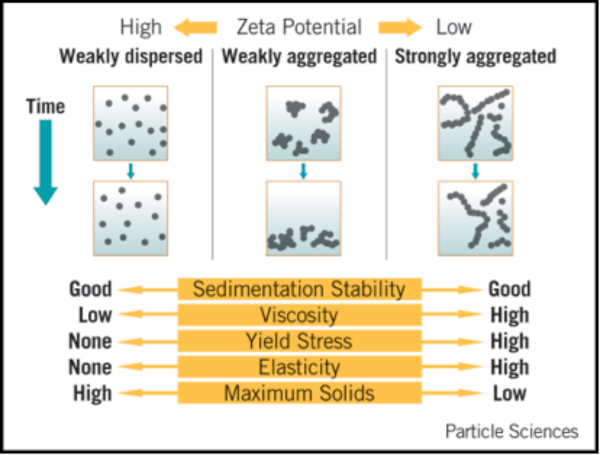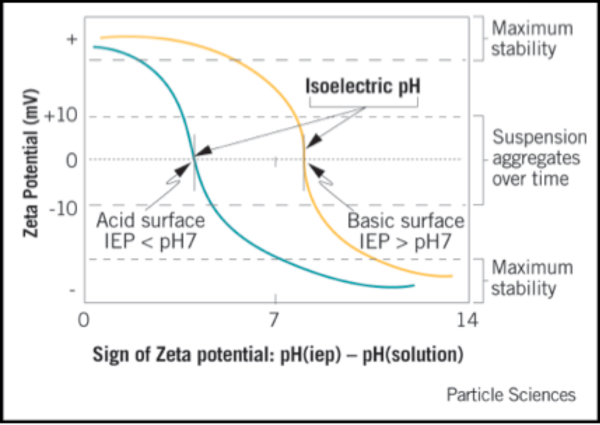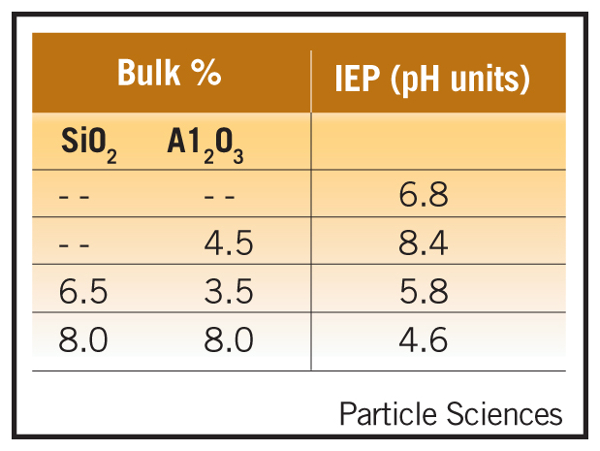Particle Sciences, Inc.
Introduction
In Parts 1 and 2 we discussed the concept of the parameter known as the zeta potential and surveyed the techniques available to determine it. In this final Part 3 we will conclude the overview on zeta potential with a glimpse at its practical broad utility and commercial significance through some applications of zeta potential measurement.
The Relation of ZP to Suspension Behavior
All suspensions are inherently thermodynamically unstable and will over time, through random motion of particles, aggregate unless sufficient repulsive forces are present (1). The repulsive force between particles, VR, which keeps particles from aggregating is given by (2):
VR = D a ψd2 [Geometric term]
where, D is a dimensionless constant related to the permittivity (dielectric constant) of the suspension medium, a is the particle size, ψd is the Stern potential and the Geometric term is a function of κa (and which varies depending upon whether κa is large or small) and the distance of separation between particles.
It is important to recognize that any soluble material added to the suspension medium will reduce the value of D and so reduce the fundamental repulsive force between particles. Examples would include dextran or water-soluble polymers that are used as thickeners or viscosity modifiers such as poly vinylpyrrolidone (PVP) and hydroxyethyl cellulose (HEC).
In Part 1, we showed how the ZP, ζ, is related to surface charge and that it can be substituted for the Stern potential, ψd, in theoretical calculations. From this we can see that, for a fixed medium (such as water), particle size and ionic strength, VR will increase as ζ gets larger. Hence, one widely used application of ZP is to monitor the stability of electrocratic suspensions. It is particularly useful to predict the resistance of such dispersions to coagulation by electrolytes, by determining the “critical ZP”, i.e. the value of ζ below which the suspension is coagulated. Table 1 lists the approximate minimum values of ZP needed to electrostatically stabilize materials of different dielectric constant in neutral (i.e. pH 7 at 25oC) water. These values are meant as guides only and should be used with reservation. API materials can be considered similar (in this regard) to polymer latex particles.
TABLE 1: Rule of Thumb for Electrostatic Stabilization

ZP measurement is often used in determining the critical coagulation concentration (CCC) of an electrolyte (the minimum concentration required for the onset of coagulation); the CCC is proportional to ζ 4/ z2 (where z is the electrolyte counterion valence).
A wide variety of products require tailor-made flow properties as an integral part of product performance requirements. Effective control of such properties relies heavily on knowledge of the effect of formulation and process variables, as well as an ability to measure and characterize meaningful flow property information. Figure 1 schematically illustrates the relation between ZP and the rheological characteristics of suspensions of materials such as clay.
FIGURE 1: Effect of Zeta Potential on Suspension Properties

A high ζ will produce a well-dispersed suspension; this, in turn results in good sedimentation stability and solids loading capacity. This type of suspension will have fluid-like characteristics, i.e. low viscosity, extremely low elasticity and relatively linear viscoelastic behavior as a function of shear or strain. In contrast, a low ζ results in particle association. The formation of a strong network structure provides good sedimentation stability but greatly reduced solids loading capacity. Here the rheological behavior would be characterized by a high viscosity, a high elasticity and a yield point at some critical strain.
Particle size (and distribution) will also play a role but only at solids loadings >20%. These will affect the degree of surface and relative inertial forces and can significantly mitigate the flow/deformation properties of the suspension.
Determination of the Iso-Electric Point of Materials
All charged materials will have what is termed an iso-electric point (IEP), defined as the condition when the value of ζ is zero. This is usually achieved by addition of potential determining ions (PDI) which, for many materials, means H+/OH- (i.e. a function of pH). It can also be attained by specific adsorption of charge modifying agents (CMA).
Figure 2 shows a schematic of a plot of ZP vs pH from which a number of important points can be noted. The first is that, at the IEP, a particle suspension will have no resistance to aggregation. This is utilized in applications such as waste water treatment, where polyvalent ionic coagulants (such as alum) are used to remove unwanted suspended material. It also means that attempting to disperse materials in an IEP solution condition is futile. Further, if the ζ of the suspension is in the range about ±10mV then it will be unstable and will certainly aggregate over time; the actual kinetics of the aggregation process are determined by a myriad of factors. If the IEP is known then the sign of ζ can be determined from the solution pH.
FIGURE 2: Effect of pH on Zeta Potential

The second point is that the magnitude of ζ increases (either side of the IEP) but eventually plateaus. Typically, this is the condition of maximum dissociation of any surface functional groups and can be used to great effect when dispersing particles; the greater the magnitude of ζ the less the need for any additional dispersing aid. For proteins and charged macromolecules the ζ value at this plateau generally increases (becomes more positive or more negative) with increasing MWt; for example, at pH 9 the ζ of different grades of gelatin can range from as low as -15mV to more than -50mV. It is also apparent that materials that carry a negative charge can be made to be positive by simple addition of PDI or CMA. This can be used to affect both particle-particle and particle-substrate interactions both o which impact formulation of API suspensions.
Finally, particles with an IEP <pH7 have acidic character while those with an IEP >pH are basic. A striking example of this is carbon black. The surface chemical properties are determined to a large extent by the distribution of oxygen-, hydrogen, nitrogen and sulfur-containing functional groups. The acid-base characteristics can be varied during manufacture and various after-treatments. Acidic carbon blacks typically have an IEP in the pH range 3-4, while basic blacks have an IEP in the pH range 8-9.
This also has implications to the process of dispersing materials not only in the choice of an ionic dispersant (anionic or cationic) but also in the choice of suspending medium (especially nonaqueous media and mixed solvents). Table 2 lists the approximate IEP of some common oxides and also some proteins; these values are meant as guides only and should be used with reservation - the actual value for a particular material can be influenced by its source or preparation method, pre-treatment and presence of trace impurities (3, 4).
TABLE 2: TheIso-Electric Point of some Materials

A very comprehensive compilation of IEP values for commercial materials has recently been published (5).
Mixing heterogeneous suspensions
Since materials are charged and will have different IEP values, then mixing suspensions of two or more can have unwanted consequences. This has important manufacturing implications in a wide range of applications, including pharmaceutical formulations. As an example, if we take alumina (Al2O3) and rutile titania (TiO2), whose IEP are at pH6 and pH9 respectively, a stable, well-dispersed suspension containing both oxides can only be obtained at a solution pH<6 or pH>9. At any pH value in-between an unstable aggregated suspension will result and the degree of aggregation and the structure created will be different depending upon the specific pH between 6 and 9. This type of problem can be eliminated by separately coating both particles first with the same CMA (such as gelatin, IEP at pH 4.8, Table 2) prior to mixing them together.
Measurement of the ZP can even be used to determine the optimum concentration for complete surface coverage of a particle with a CMA as illustrated in Figure 3 for wax nanoparticles. Here maximum coverage is attained at approximately 2vol% CMA as indicated by a constant ζ of ca -80mV.
FIGURE 3: Effect of Adsorption of an Anionic CMA onto Wax Nanoparticles

Polymer latexes, prepared by emulsion polymerization, are typically stabilized by an adsorbed layer of surfactant (e.g. an ionic species such as an alkyl sulphonate) which is utilized to control the product’s particle size. This can provide a fairly high ζ of around -40mV to -60mV in water at pH 5/6.
As is evident, a “high” value of ζ indicates the likelihood that a suspension will be stable. Conversely, a low ζ means that the suspension will aggregate. Having a “high” ζ is, however, no guarantee that a suspension will be stable under all conditions. This is because ζ measurements are made on quiescent systems (i.e. at rest). During formulation and production stages many suspensions are often subject to shear (by pumping or stirring) or heat and this additional mechanical or thermal energy is oft-times sufficient to promote aggregation.
The stability of such latexes, both on storage and on mixing with polymeric solutions can often, however, be enhanced by adding, post-manufacture, additional surfactant to the latex suspension. It may, at first, seem surprising that an anionic (negatively charged) species can adsorb onto a negatively charged surface. This is because, in many cases, the latex surface is never fully occupied by surfactant molecules during the polymerization reaction, since usually the amount of surfactant added was determined empirically. As mentioned above, the adsorption process can be followed directly using ζ measurement and it is not unknown to obtain an increase of over 50% which would result in a much greater tolerance to mechanical and thermal action.
Qualifying material
It should not be assumed that different lots, or batches, of the same material will necessarily have the same ζ vs pH profile or even the same IEP since it is difficult, if not impossible, to control precisely the nature of particle surface charge in any manufacturing process. For example, it is not unknown for the IEP of the same grade of rutile TiO2 to vary by as much as 2 pH units; depending upon the source and processing, different grades of gelatin can have IEP values ranging from 4.0 to 8.0. Thus, an assumption of ζ uniformity for a material can have disastrous consequences in formulation. This is especially true of natural materials such as clays. Thus, it should never be assumed that “similar” materials from different suppliers will be isocratic equivalent. Further, many materials have “coatings” applied (as will be evident from inspection of the MSDS supplied with the material). For example, rutile TiO2 is often surface-modified with silica and alumina and the IEP varies dramatically with different ratios of silica:alumina (Table 3).
TABLE 3: Effect of Surface Modification on the IEP of TiO2

However, the bulk percentages of each chemical determined from elemental analysis are not a reliable indicator of how the surface will behave in solution. Thus, it is critical that the ζ vs pH profile always be checked for any material prior to use.
CONCLUSION
ZP (ζ ) measurement is a very useful but often under-utilized technique that can provide information about the material surface-solution interface. Knowledge of ZP can be used to predict and control the stability of suspensions and emulsions; measurement of ZP is often the key to understanding dispersion and aggregation processes. The presence, or absence of charged groups/moieties on the surface of materials, as revealed by their ZP, can directly affect their performance and processing characteristics in suspension.
The sign and magnitude of ZP affects process control, quality control, product specification; at the simplest level, it can help maintain a more consistent product and at a complex level it can improve product quality and performance.
REFERENCES
1. Lyklema J. Fundamentals of Interface and Colloid Science. Amsterdam, The Netherlands: Elsevier Publishing Company; 1991
2. Kruyt HR (ed), Colloid Science. Volume 1. Amsterdam, The Netherlands: Elsevier Publishing Company; 1949
3. Solomon DH, Hawthorne DG (eds), Chemistry of Pigments and Fillers. New York, NY, USA: John Wiley and Sons; 1983
4. Parfitt GD, Sing KSW (eds), Characterization of Powder Surfaces. New York, NY, USA: Academic Press; 1976
5. Kosmulski M, Surface Charging and Points of Zero Charge, Boca Raton, FL, CRC Press; 2009